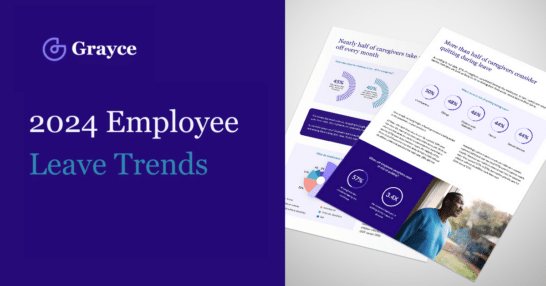Chief Human Resource Officers and benefits leaders face a multi-pronged challenge: the need for leaves of absence is increasing, the reasons for taking them are expanding, and yet, this growing population of caregivers isn’t getting the support they need. Because of the shortage of care providers, many employees are faced with a difficult choice: pay for expensive support—or exit the workforce, sometimes for good.
Left alone, this challenge could lead to employee retention and talent attraction issues; issues organizations can’t afford to ignore. This is a call to action for HR leaders everywhere to shift their focus to a proactive, comprehensive approach to paid leave—one that prioritizes family care support.
Unsure if your organization should be taking measures to support your caregivers? Here are three signs to look out for:
#1: You’re having trouble retaining, or attracting talent
Caring for a loved one is now the number one reason talent is leaving the workforce, behind early retirement. And as a result, employers are losing $44 billion annually due to caregiver turnover and absenteeism.
According to WTW’s 2023 Leave, Disability and Time-off Trends Survey, most (84%) employers are planning to make changes to their leave programs in the next two years, and nearly three-quarters (73%) attribute this to their need to meet retention and employee experience goals.
But, giving people time away doesn’t always solve the problem.
Here’s an example: According to the Anxiety and Depression Association of America, caregiving is a significant cause of mental health issues: 57% of caregivers report experiencing clinically significant levels of stress, anxiety, or depression; 38% of family caregivers find their situation extremely stressful; and 20% of family caregivers suffer from depression.
In many of these cases, paid leave isn’t the answer. Instead, caregivers need support.
Ellen Meza, Senior Director, Global Benefits, Well-Being & Mobility at DocuSign observed this support gap first-hand.
“After examining employee engagement surveys and having conversations with employee groups, we found that employees were struggling in providing care for aging, ill, or vulnerable loved ones,” she said. “It was really clear that we needed to support our employees in ways that we hadn’t before.”
Enter Grayce. Our multi-pronged approach directly addressed the root cause of employees’ family care-related anxiety, stress, and depression—identifying where employees really need support, taking tasks off their plates, charting a plan forward together that makes use of existing employee benefits, and building resilience through community connection.
In fact, a study of Grayce members found one in two leaves can be avoided when the right programs and caregiving support are in place. And over half of members say Grayce has helped them prevent a resignation, leave, or reduction in work hours.
If your goal is reducing the number of employees who take leaves of absence (planned or unplanned), retaining employees (i.e., making sure they come back after leaves of absence), and attracting talent, offering caregiving support is the better intervention for those business objectives.
Offering the right support can help you get ahead of the curve, so you can attract top talent and retain the valuable employees you have working for you today.
#2: You aren’t seeing expected utilization
It’s a common problem across organizations everywhere: employees aren’t utilizing their benefits offerings.
A survey conducted by One Medical found that only 19% of employees used their available benefits in 2022, even though two-thirds said they were struggling with mental health or behavioral issues.
Another example, utilization of Employee Assistance Programs (EAPs) averages befow 10% according to SHRM.
Today, the fastest growing reason why people take leave is to take care of mental health when it all becomes too much.
Benefits leaders are at a loss. They’ve invested time, money, and talent into standing up programs and extending leave policies—many targeted at supporting key employee population groups, such as leadership, women, and people of color—but they’re not seeing a return on their investment. Employees are taking leave more than ever; medical costs are still rising; employee retention is waning; and employees are reporting heightened levels of stress and burnout.
It’s a catch-22.
Certainly, being offered the right benefits at the right time makes all the difference.
Many companies attribute underutilization to a lack of communication; employees simply don’t know the benefits exist.
That’s where Grayce steps in. As a central hub for all care needs, we help educate and enroll people at the time when they need it most. In solving for member challenges, Grayce makes full use of your existing benefits ecosystem. And the results are palpable: Grayce customers report a 58% increase in the utilization of other relevant employer benefits.
#3: You’re expecting time away to lead to business results
We agree: Leaves of absence are a necessary tool for supporting employees. But, they are an expensive business strategy—and at times, a reactive one.
Nowadays, employees have new and diverse reasons for taking leaves from work: mental health, to care for children, aging parents, and sick loved ones; to serve in the military; to address serious health conditions; bereavement; family upheaval; and more.
Some leaves are planned for, while others are sudden and unplanned—making them difficult for the employee to navigate and the employer to manage.
Still others are faced with a difficult choice: taking time away may not be the right solution, but it’s the only solution they can see because they have nothing else to try.
Indeed, leaves of absence are not a one-size-fits-all solution to caregiver support.
Instead, taking proactive measures, such as offering access to personalized resources and community works to not only address root causes, but also improve health outcomes—allowing employees to return to work sooner, or avoid unnecessary leaves in the first place. That’s why WTW’s 2023 Leave, Disability and Time-off Trends Survey predicts that by the next two years, about 50% of employers will offer formal caregiving support to their employees.
Offering holistic caregiving support to complement your current leave of absence policy can help you achieve your desired business outcomes.
A holistic caregiving support strategy will:
- Be preventative: Taking a leave of absence isn’t always the answer. The right programs in place can help prevent the need for taking leave. We find one in two people on the brink report avoiding a leave of absence or time away after working with Grayce.
- Address root causes: Support health equity and SDoH by getting at the heart of why employees take leaves of absence to prevent and/or shorten the need to take them.
- Support the diversity of employees in your workforce: All employees have loved ones. Supporting all employees—across all care issues—means better and faster access to the right benefits and tools they need (and less of an administrative burden on you).
- Help you understand your employees’ needs better: Knowing who is using your programs—and benefiting from them—can point you towards the gaps in your benefits offerings, where you’re losing money (e.g., recruiting new employees), and how to drive better employer brand awareness and advocacy.
- Support your business goals: Boost employee retention by helping employees stay connected to—and feel supported by—your company throughout their leave of absence. Doing so will also increase the utilization of your entire benefits ecosystem, maximizing the investments you’ve made in your existing benefits offerings.
How Grayce can help
While leaves of absence should continue to be part of a comprehensive employee benefits strategy, forward-thinking organizations will lead with proactive family care support—addressing the root cause stressors with community, personalized care plans, and hands-on support from experts.
At Grayce, we support employees by:
- Doing the legwork, including taking tasks off their plate as well as helping families navigate employer, local, and government resources, across medical, legal, financial, social, emotional, and functional problem areas.
- Looking at things holistically and developing long-term solutions through strategic care planning.
- Employing the most skilled people. No other care solution matches the depth of support provided by our Masters-level Care Partners, informed by 5+ years of experience in the field. They’re not only the most knowledgeable, but also the most efficient and share the responsibility for next steps.
Together, we can help you support employees in navigating and resolving the care challenges pushing them to the brink at a time when they need it most. In fact, 54% of our members say Grayce has helped them prevent a resignation, leave, or reduction in work hours.
If you’ve already tried extending leave of absence without seeing the results you hoped for, discover how family care before, during, and after leave has had a transformative effect for peers in your industry.
Suggested for you

Blog
4 key components of a successful family care benefit program
Explore the vital elements of an effective family care benefit program and gain insights from the Okta and Grayce partnership, serving as a model for businesses seeking to enhance employee well-being, remain competitive in hiring, and enhance retention.



